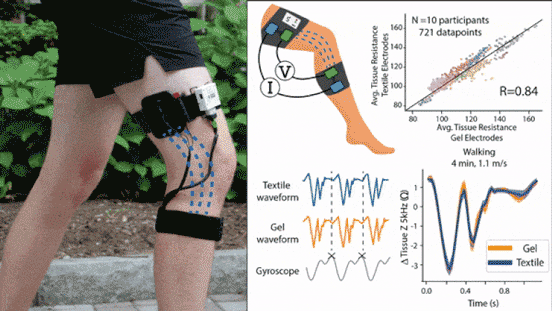While wearable health monitoring technology continues to rapidly progress, technology for tracking musculoskeletal health is limited in everyday settings. Usability constraints limit many sensors’ utility for wearables in daily living where symptoms can dynamically change – delaying treatment and potentially worsening patient outcomes. Multi-frequency electrical bioimpedance analysis (MFBIA) shows promise for tracking musculoskeletal health but relies on gel electrodes, hindering extended at-home use. We aimed to address this need for usable, at-home musculoskeletal health assessment technology by designing a wearable adhesive-free MFBIA system using textile electrodes and rigorously testing its performance in extended mid-activity use.
We constructed an adhesive-free wearable system for leg MFBIA and evaluated its functionality with multiple textile electrode materials under realistic wear conditions (5 participants, 45 measurements). We then compared mid-activity textile and gel electrode MFBIA waveforms across multiple compound movements, as well as over 8+ hours of continuous, unsupervised measurement to evaluate the accuracy of textile electrode MFBIA at recording both short-term and long-term changes in leg MFBIA during uncontrolled daily living (10 participants, 80+ measurement hours).
Mid-activity MFBIA measurements with textile electrodes agreed highly with (ground truth) gel electrode measurements (average r^2=0.95), with <1 Ohm differences (0.618±0.340Ω) across all compound movements. Longitudinal changes in leg MFBIA were also successfully measured during extended use in uncontrolled daily living (repeated measures r=0.84). Participants rated the system as comfortable and intuitive (8.3/10), and all participants were able to don and operate the system without guidance. This study demonstrates that textile electrodes can be a viable substitute for gel electrodes when incorporated into wearable MFBIA devices for use in dynamic, uncontrolled settings. Our work suggests adhesive-free MFBIA can improve healthcare by enabling robust wearable musculoskeletal health monitoring in at-home and everyday settings.

